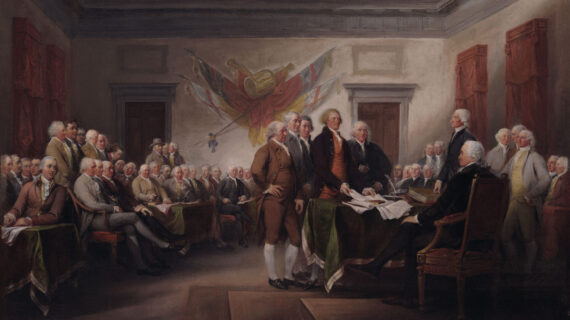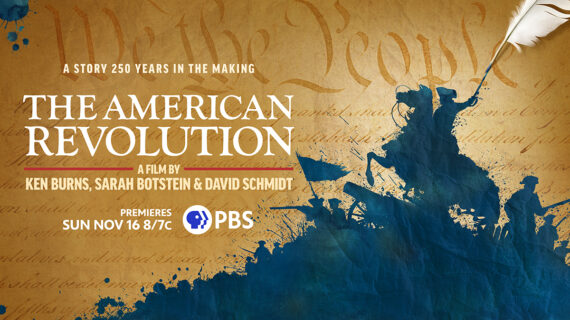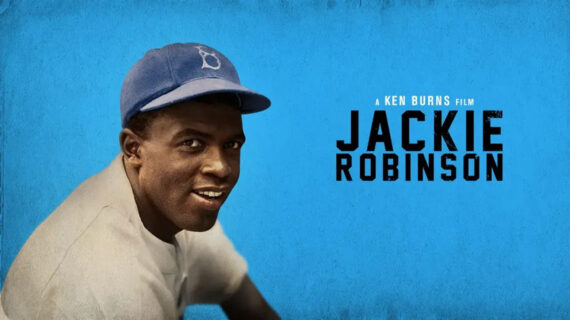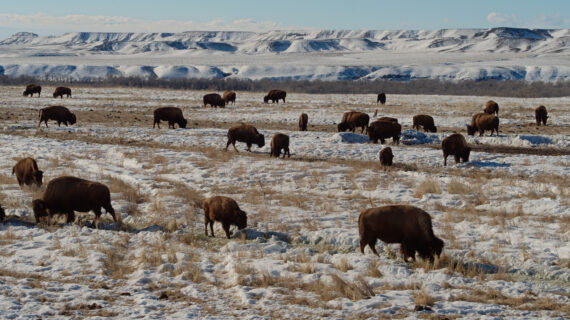[music]
On behalf of the Stockbridge-Munsee tribal community, we have a proclamation, in honor and recognition of Ruth Gudinas and Dorothy Davids, members of our community, tribal members, respected elders, who have taught us that we must resolve a fierce dedication to education, even in the face of any adversity. In honor and recognition of you two, and your commitment to address the social injustices in society through education and understanding and practical wisdom– that’s not here, that’s me– and in honor of your lifetime commitment to our community through your dedication to the Historical Committee and its work, as well as your efforts toward providing a forum for education on Mohican history through the annual Mohican History Conference. Now, therefore, the community declares that a feast will be held in your honor, celebration and recognition.
[applause]
[music]
Stockbridge-Munsee Mohican History was funded in part by Irene Daniell Kress, Francis A. and Georgia F. Ariens Fund of the Community Foundation for the Fox Valley Region, Evjue Foundation, Ron and Patty Anderson, Ira and Ineva Reilly Baldwin Wisconsin Idea Endowment, National Endowment for the Humanities, and Friends of Wisconsin Public Television.
[rippling stream]
– Koolamalsi. Good morning! My name is Kim Vele. I’m an enrolled member of the Stockbridge-Munsee tribe, otherwise known as the Muheconneok, which means “people of the flowing water.” And I will begin with Kishelemukonk [speaking Delaware language] which means “Thank you, Creator, for this beautiful day and the opportunity to share my tribe’s story with others.” We’re not aboriginal to Wisconsin. We are one of the– what is commonly known as one of the New York tribes, and originally occupied much of the land north of Albany, all the way into Lake Champlain, along the Hudson River, which is a large river that ebbs and flows with tides, is why my people are known as Muheconneok, people of the flowing waters. The shortened version of that is Mohican. The Hudson River has many islands, and one of the islands, which is called Schodack Island, is one of our great counsel fires.
And that is where our ancestors met and took care of business for the tribe. It’s where the sachems resided and was the center of the government, basically. Until the Dutch came, and it’s believed that my ancestors were among those that greeted Henry Hudson when he first came up the Hudson River, helped him and his crew survive. And it was during that time that diseases started to spread throughout the tribes in the upper New York area, including my tribe. Continuing factions and warring between the Mohawks and the Mohicans resulted in a dramatic loss of members. Eventually, it was very difficult for some of the remaining bands to continue to survive in that area. We have historically had approximately three sachems in the tribe, which would be known as chiefs. One would be the chief of the people and deal with essentially issues that would be unique to just our tribe and our tribe’s issues. And then we would usually have a spiritual sachem who would guide the tribe on a spiritual level and guide the other sachems in a spiritual way. And then we also had basically what would be the international diplomat, if you will, and that sachem would be, basically, the chief among other bands of our tribe and other tribes.
At the time we had two sachems, Umpachene and Konkapot. They were approached by Scottish missionaries to missionize and stabilize the tribal membership and advocated for Christianization of the tribe and, I think, convinced Umpachene and Konkapot that this might be a good idea for survival. Neither one of the chiefs wanted to bind the membership with that decision without first taking it back, had numerous meetings with the tribal members and came to a decision that maybe this was best for the tribe, to set up, basically, a reservation in western Massachusetts. And I don’t think people really understand how difficult that is for a people, to leave your homeland, you know, that you have been there for thousands of years, to walk away from everything that is familiar to you to go someplace new. This is about 1732, and at that time two townships were set aside for our members. They actually became members of a town board, so to speak, and set up a mission school, set up a sawmill, set up a gristmill, and learned farming, became Christianized, and became educated. Some of the members started the Indian School, which, I think, is the predecessor to what is now Dartmouth College. The Berkshires, where they settled, is supposedly geographically similar to an area in England known as Stockbridge. So, it was easy for people to always refer to us as the Stockbridge Indians. And so, to this day, we carry that English name forward, but in our way and in our traditions, we are Muheconneoks.
We lived fairly peacefully during that time, in western Massachusetts, until the American Revolution broke out. We have a significant history of fighting in wars, and our members chose to fight for the colonists. There are very significant battles that are commemorated, involving many Stockbridge who sacrificed their lives during that time. And it was following the war that the men returned back to Stockbridge, Mass, and discovered that a lot of the missionaries and non-Indians had taken over the farms and the land, and the children and the elders and the other members were pushed back into wigwams in the woods. There was a lot of struggle to regain that land. Petitions were filed with the territorial government of Massachusetts to no avail. And because it had such a devastating impact on the membership, the New York Oneida tribe invited the Stockbridge back to New York, where they had a reservation. So, the membership moved back and were given a reserve within the New York Oneida’s reserve, which is known as Stockbridge, New York… and did the same thing again: set up a mission house, a school, set up a gristmill, got farming, built homes. And it wasn’t long after that that the federal government’s policy was to remove tribes from aboriginal territory.
There was a lot of tension between non-Indians and fights over the land. And the policy shifted then to move all of the Eastern bands and Eastern tribes west of the Mississippi. And the migration out of New York started in, I think, about 1819, 1820 to what is now Muncie, Indiana. The Munsees had also promised us some land there as part of their treaty, but by the time some of our members got there to stake a claim, the Munsees had been deprived through another treaty of their treaty reservation. So, both the Munsees and the Stockbridge were out, and joined, and moved to the next place, which was around Lake Winnebago. And that’s where we get the Stockbridge-Munsee Indians. In fact, some of our members are from the Munsees. We were continuing to be forced west, and… the tribe was really, really resisting that. So, being the diplomats that they are, began to negotiate with the Menominee tribe directly for some kind of property to allow us a permanent settlement.
And, in fact, the Menominee tribe and the Stockbridge tribe reached agreement and submitted the agreement to Congress for ratification and approval, and it was denied. Congress then did get involved in establishing a reservation. And the reservation here in Wisconsin was established by a treaty of 1856. So this is where we have been ever since. They built log homes. They had to clear the land. Work horses pulling these huge roots, burning and clearing, and the toil that it took to move some of the boulders just to clear a field to plow and plant a garden. We set up the mission house, set up another school. Electa Quinney, one of our members, opened the school up, and the tribe opened the school up to be a public school. And that was before Wisconsin was a state, so we stake her claim as being the first public school teacher of Wisconsin, which we’re very proud of.
She wrote a brief history of the tribe. And her father, John Quinney, wrote a brief history, and some of his speeches survive. They are very eloquent. John was a sachem, made many trips back to New York for redress of the loss of our lands in New York, to no avail. Throughout the years, that’s something that we carry with us from generation to generation. We have always been a very political people, politically active, never afraid to stand up for what we believe is right and just, and with a significant, dignified eloquence. I think education has impacted, and that is also a very significant value in my tribe, to be educated, to educate our youth. And so, we believe in education, and everywhere we’ve traveled along our many trails, one of the first things we’ve done is establish a school and get a teacher for the children. And I think along the way, that’s really helped to be the kind of diplomats that our ancestors proved to be. Some of their letters and speeches, that I read now, are amazing.
I wish I could write half as well as they. I wish I could make these eloquent, compelling arguments and speeches that they made, but I’m really inspired by their words and their vision. And I think it’s only through their vision that we really have survived as well as we have over the years, despite of all these things that worked against us.
The federal government is what I call “schizophrenic” in their policies. And it depends on who’s in political power, whether they want to see tribes survive or whether they don’t, whether the goal is termination and assimilation. It changes with the wind. And we even realize that today throughout the 200-, 300-, 400-year history that we have working with federal and state governments that it really depends on who’s in political power as to how much sovereignty and how much respect you get nation-to-nation. But I think what people don’t realize is the United States government set it up in the U.S. Constitution that tribes would be dealt with on a treaty basis, and that this was an issue for the federal government and not local and state governments to really address. So when people talk about how unique tribes are, it’s because of that legal history that we have and being included in the U.S. Constitution. I think that the impact of colonization, Christianization, re-education, the boarding school, eliminate the language, beat the Indian out of you, and assimilate, and be good people, dramatically had an impact on us as a people.
And you see that wave going from east to west. The tribes that are the furthest point west had that experience in later years, but, you know, having first been introduced to the colonists so much earlier than the other tribes, we have a longer history of being without. So, our language all but died, and the history conference has always been about re-discovering ourselves through what’s written and combining it with what’s carried through oral traditions in our families. A lot of this was done when we were invited to attend by scholars in New York having the annual Mohican Conference. Some people, non-Indians, it’s amazing, they live their entire lives just studying histories and traditions and things about our tribe. But, it was really important, I think, for the history committee to make corrections to some of the record and to really tell the story from our perspective. Because,I mean, it’s our history.
[laughing]
I know people are really well-meaning, but it doesn’t have the same sense of importance and truth as it is when it comes from the very people you are speaking about. So, I think that’s the most significant thing about our Mohican History Conference is the majority, if not all, of the presenters were enrolled members who are re-discovering things about our tribe.
A lot of the history kind of gets lost in time and movement and translation, but there is a lot of written work that’s preserved that we can go back to and piece together and learn. So, a lot of our culture is coming alive again after being repressed. You know, things have a way of just coming in a big circle… which is central to our beliefs, and in everything we do.
[drumming]
Our language, we’re part of the Lenape family. We started language camps. Some of our members are getting to the point where they can carry on conversations. Prayers are being said in the traditional language, and we brought our drums back. And the drum in our culture represents the heartbeat of life, and so to be part of a drum and to have a drum be part of everything that you do, reminds you of how central it is.
Everything is a circle. A drum is a circle of singers; there’s power in a tornado, which goes in a circle; robins and birds make their nests in circles; life and death is a big circle; and our seasons are circular. Everything about our life is in a circle, if you think about it, and we are at the center of the circle, as human beings. And, so, when we refer to bringing the drum back, there was a period of decades where the drum was pagan, and it was a bad thing, and you should not practice your religion, you should not speak your language. You need to be good Christians, and speak English, and cut your hair, and assimilate. And this wasn’t just taught. I mean, you were beaten, beaten as a human being if you did these things. So, you have a couple of generations of our ancestors who were afraid and couldn’t. And you lose that when it’s not passed from your grandparents to your aunties and uncles and to the children. And that’s been resurrected.
And there are more and more people going back to the drum and going back to those basic beliefs, because that’s what makes you whole as a person. If you live what we call “in the traditional red way”, it means that you recognize that you’re part of a greater circle, that you are interrelated and related to everything around you and about you… Everything, your environment, the air, the water. Water is considered the blood of Mother Earth, and to not have that sacredness in everything that we do is heartbreaking. But the fundamental issue is, our polluting our Earth, and the waters that we rely on to drink, and the air that we breathe. And this goes back to those things that we need to survive as a people, as a human being, not just as a tribe, but as human beings. And until we understand and protect all those relationships, we’ll die… we’ll die. I consulted with our historic committee members and elders in the community, and I asked them, “As the representative for the tribe, what would you like the message to be that I carry?” And it is always very simple: that we survive, that the last of the Mohicans Fenimore Cooper talked about is not true, we still live.
And people need to know that. I think it’s hugely significant that we survived against all odds, and that we know how to survive. If you don’t have food you make food, you hunt, you fish, you gather. And so, our land is so central to how we live because if gaming were to go away or something catastrophic would happen and we were all off the grid, we have land here that we know, as a people, we could survive. And that’s so important because I think we always lose track of what’s really, really important in our lives, and it is just basic food, being together, breathing clean air, drinking clean water. And these are fundamental values that go to the core of who you are as a people. And it’s not just for our tribe. As human beings, our very survival depends on it. I think that’s something that we carry. We’re a spiritual people.
You know, Christianization, some are very Christianized still to this day. We have faith. Some believe in the Creator, some believe in God. We have different–
We represent different religions, but that spirit and that faith, I think, also carries us as human beings. So, our emblem is called “many trails” to exemplify all the different removals that we’ve had, from east to west, and all the times that we had to just set up and make homes and then leave. And you’ll see in the Many Trails sign, the sign of the Cross, which indicates our Christianization. We have a lot of teachers in our tribe today and they’ve been very active in developing curriculum to teach children about the tribe’s history. And one of the exercises they have is for the children to move in the classroom from station to station and start something and not be able to finish it and be told, “Now you need to move to the next station.” And the children, you’ll see, “I’m not done!”
or “I’m not finished!” or “Why do I have to move?” And it’s like, “Nope, just move! We said ‘Move’, move now!” It really illustrates for the children to understand what that’s like, to move, move, move. Redo, redo. Start over. So, there is a resilience there and it’s a strength. Probably from our faith and knowing the basics on how to live. And we are reminded of that all the time.
Just a couple months ago, one of our elders came to open session at a tribal council meeting and said, “What are your plans as our leaders if something were to happen and our grid shut down? Remember, we need to survive.” So, it’s part of our planning, you know. We’re ready. Bring it on!
[laughing]
– To learn more about the sovereign Indian nations in Wisconsin, visit WisconsinAct31.org. To purchase a DVD of this and other Tribal Histories programs visit wpt.org or call (800) 422-9707.
[music]
Stockbridge-Munsee Mohican History was funded in part by Irene Daniell Kress, Francis A.
and Georgia F. Ariens Fund of the Community Foundation for the Fox Valley Region, Evjue Foundation, Ron and Patty Anderson, Ira and Ineva Reilly Baldwin Wisconsin Idea Endowment, National Endowment for the Humanities, and Friends of Wisconsin Public Television.
Search Episodes
Related Stories from PBS Wisconsin's Blog

Donate to sign up. Activate and sign in to Passport. It's that easy to help PBS Wisconsin serve your community through media that educates, inspires, and entertains.
Make your membership gift today
Only for new users: Activate Passport using your code or email address
Already a member?
Look up my account
Need some help? Go to FAQ or visit PBS Passport Help
Need help accessing PBS Wisconsin anywhere?

Online Access | Platform & Device Access | Cable or Satellite Access | Over-The-Air Access
Visit Access Guide
Need help accessing PBS Wisconsin anywhere?

Visit Our
Live TV Access Guide
Online AccessPlatform & Device Access
Cable or Satellite Access
Over-The-Air Access
Visit Access Guide
 Passport
Passport














Follow Us